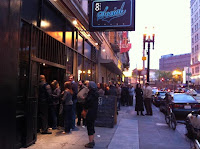The one downside to being an arts critic / reporter is that you’re not supposed to leave performances before the curtain comes down.
I completely understand this rationale: A review or feature story based on incomplete knowledge is hardly fair to the performers or readers. Not to mention the people in the audience that might be put out by you hopping out of your seat in the middle of a show.
When critics are given aisle seats, it’s supposed to be to help them get to their laptops so they can file their reviews more quickly. The system wasn’t set to accommodate those who need to get out prematurely.
At this point, though, I can’t decide whether years of sitting in theatres has provided me with a really high tolerance for terrible shows — or a really low one.
Most of the time, my tolerance is really high. I love going to see live performance. There’s always something to be learned, and even when a show really stinks, I’ve figured out how to focus on various thoughts, sights, sounds and even smells particularly intently (wow, look at that amazing stucco ceiling; the seat feels a little threadbare etc) to help me get through it. Let’s call it a form of meditation.
However, there are occasions — thankfully I can still count them on the fingers of one hand — where not even a yogic trance can save me from wanting to stab out my eyeballs and run screaming into the street.
Such, sadly, was the case on Tuesday night, when I went to see the Voca People show at the Marine’s Memorial Theatre in San Francisco. Within about five minutes I knew I had made a horrible mistake in going to the show. I expected it to be cheesy fun. But I didn’t expect to have my intelligence insulted by a bunch of babbling, white-clad, Blue Man Group-knockoffs.
Voca People, an eight-member, mixed a cappella singing group, has gained an enormous following in this country and abroad. It’s clear that the five male and three female performers have quite good voices. It’s also evident that there are people on the Voca People team who have great musical arranging skills. But the show consists of nothing but boring, corn-syrup-infused medleys of greatest hits from the western musical cannon (from The Queen of the Night’s aria from The Magic Flute to the theme tune from Rocky.) And with no more than ten seconds devoted to any single song to allow the singers and arrangements to settle in, it’s very hard to appreciate any of the skill on display.
The premise — a group of singing aliens coming to Earth and wishing to find out about the human race by absorbing and regurgitating their songs — is inane. As if global vocal music culture can be encompassed by western pop and classical music. And the comedic schtick, such as it is, does nothing except appeal to lowest common denominator life forms.
I felt valuable minutes of my life sliding by, irrecuperably. I tried deep breathing but it didn’t work. By half an hour in, I was digging my nails into the arms of my seat and clenching my toes in my sandals. After an hour, I thought I was going to throw up. There was no choice but to leave.
If the chunk of the show I missed turned out to be fantastic, then I guess I’ll have to beg the forgiveness of my readers, and vow to bring an emergency sick bag to all future productions I attend to avoid having to leave prematurely ever again.
But somehow, I doubt that Voca People evolved much beyond what I’d already witnessed that night.
Either way, I guess I’ll never know.
What I do know, however, is that life’s too short for performance that causes this much pain. So, much though in principle I believe it’s a terrible, unprofessional thing for an arts journalist to scurry out of a theatre early, sometimes you have to make exceptions to the rule. I don’t regret a thing. It made the emergency double whiskey I chugged down at the pub next door especially tasty.








